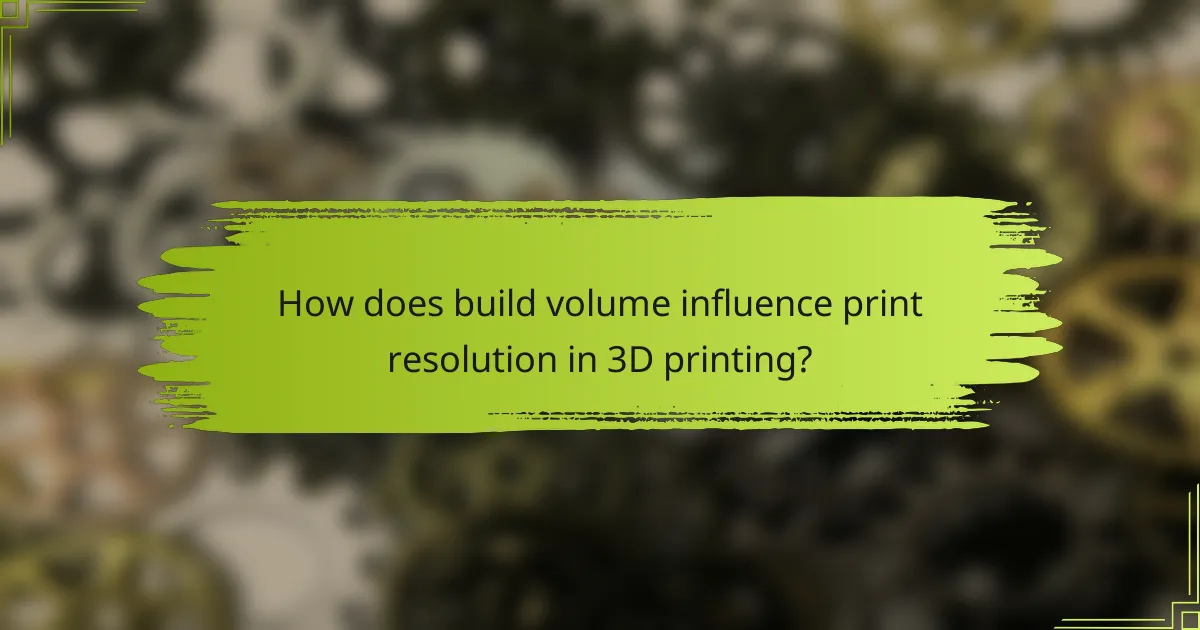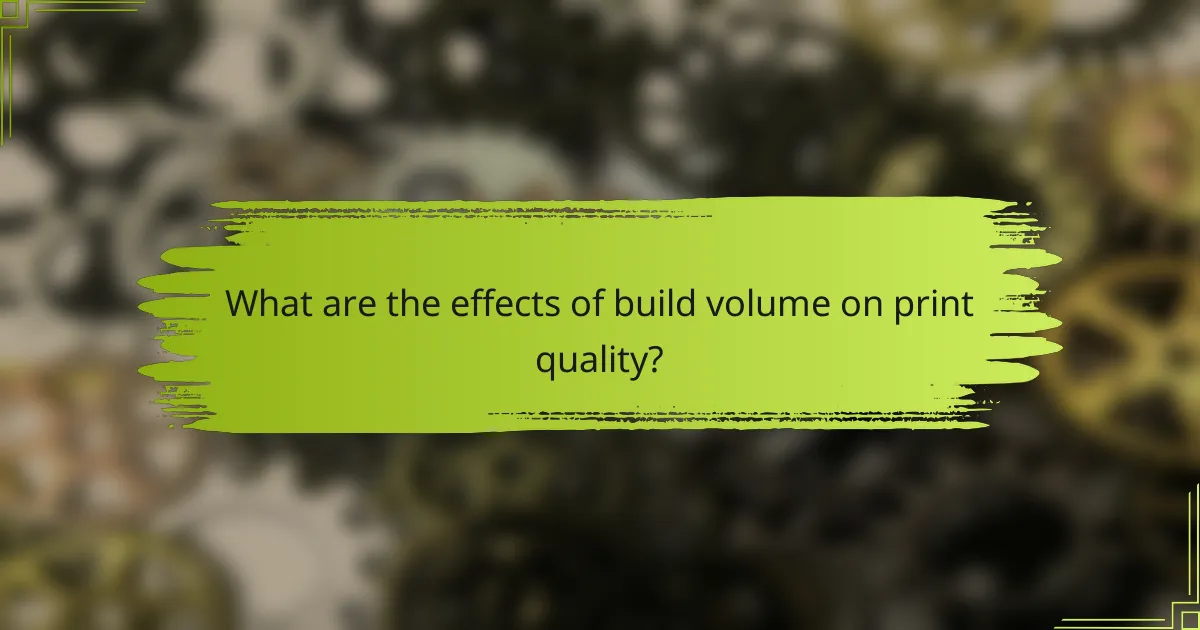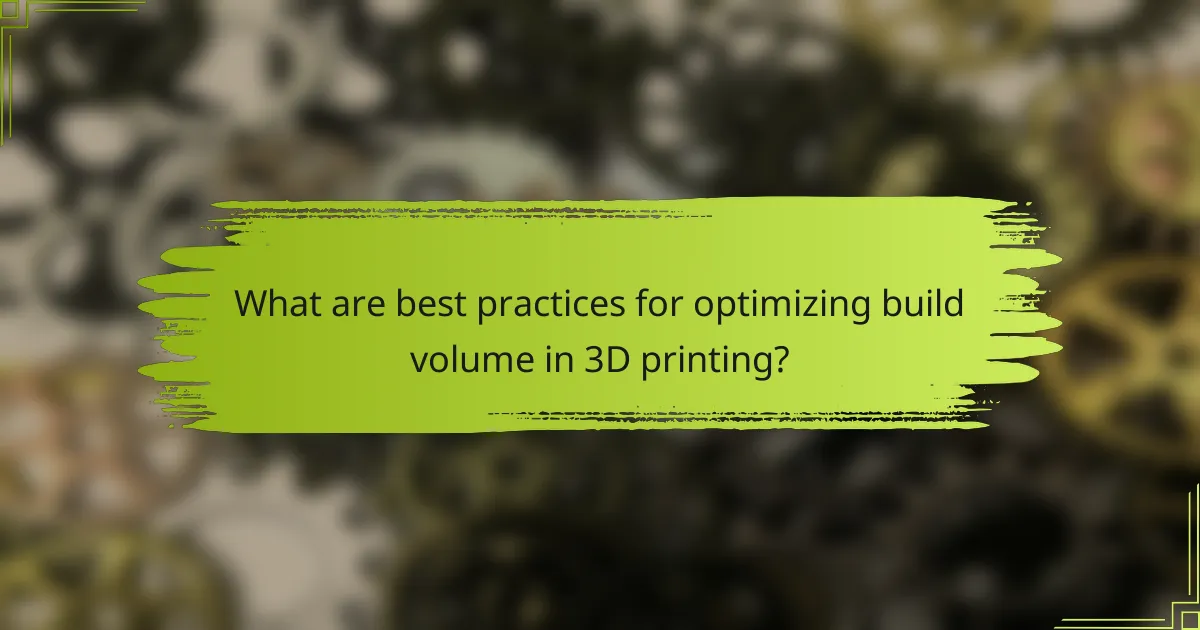
How does build volume influence print resolution in 3D printing?
Build volume significantly influences print resolution in 3D printing. Larger build volumes can lead to lower resolution due to increased distances between the print head and the build plate. This can result in more noticeable layer lines and a rougher surface finish. Conversely, smaller build volumes often allow for higher precision and finer details. The proximity of the print head to the build plate enhances the printer’s ability to control extrusion and layer adhesion. A study by the University of Southern California found that printers with smaller build volumes achieved resolutions of up to 50 microns, while larger volume printers typically maxed out at 100 microns. Thus, the relationship between build volume and print resolution is critical for achieving desired print quality.
What is print resolution and why is it important?
Print resolution refers to the detail an image holds, measured in dots per inch (DPI). Higher DPI indicates greater detail and clarity in printed images. Print resolution is crucial for producing high-quality prints in 3D printing. It affects the smoothness of surfaces and the accuracy of fine details. Low resolution can lead to pixelation and loss of detail. For instance, a print resolution of 300 DPI is typically required for professional-quality images. In contrast, 72 DPI may suffice for web images but results in lower quality prints. Thus, understanding print resolution ensures optimal output in 3D printing applications.
How is print resolution measured in 3D printing?
Print resolution in 3D printing is measured by the layer height and the precision of the printer’s movements. Layer height refers to the thickness of each printed layer, typically ranging from 0.1 mm to 0.3 mm. The lower the layer height, the finer the detail that can be achieved in the final print.
The printer’s movement precision is often expressed in microns, indicating how accurately the print head can position itself. For example, a printer with a movement precision of 10 microns can produce highly detailed prints.
Both layer height and movement precision directly influence the overall resolution and quality of the printed object. Higher resolution results in smoother surfaces and more intricate details. Therefore, effective measurement of print resolution involves evaluating both layer height and movement accuracy.
What factors contribute to achieving high print resolution?
High print resolution is influenced by several key factors. The printer’s nozzle diameter plays a critical role; smaller nozzles produce finer details. Layer height is another significant factor; thinner layers enhance the resolution of the final print. Print speed affects resolution as well; slower speeds allow for more precise material deposition. The quality of the filament also impacts resolution; higher quality filaments yield better surface finishes. Temperature settings must be optimized; incorrect temperatures can lead to poor layer adhesion and detail loss. Additionally, the printer’s calibration is essential; well-calibrated machines produce more accurate prints. Lastly, the design complexity affects resolution; intricate designs may require higher resolution settings to capture details accurately.
How does build volume affect the printing process?
Build volume directly impacts the printing process by determining the maximum size of the object that can be printed. A larger build volume allows for bigger prints, accommodating complex designs and multiple objects in one session. Conversely, a smaller build volume limits the size and complexity of prints. This can lead to increased assembly time if larger objects must be printed in parts. Additionally, the build volume can influence print speed; larger prints may take longer to complete. The precision and quality of prints can also be affected, as larger volumes may require more calibration to maintain accuracy. Overall, the build volume is a critical factor in 3D printing that influences design possibilities, print time, and end quality.
What is the relationship between build volume and layer height?
Build volume and layer height are interconnected in 3D printing. The build volume refers to the maximum dimensions an object can occupy during printing. Layer height is the thickness of each individual layer that is deposited during the printing process.
A larger build volume allows for the printing of larger objects but may require a proportionally larger layer height to maintain structural integrity. Conversely, a smaller layer height can enhance detail and resolution but may result in longer print times, especially in larger prints.
Research indicates that optimal layer height often correlates with the nozzle diameter and the capabilities of the printer. For instance, a common recommendation is to set the layer height to 75% of the nozzle diameter for efficient printing. This relationship ensures that the printer can effectively manage the material flow and adhesion between layers.
How does build volume impact the speed of printing?
Build volume directly impacts the speed of printing. A larger build volume requires more time to print larger objects. This is due to the increased amount of material being processed. Additionally, the printer head may need to travel longer distances. This can lead to longer print times compared to smaller volumes. For instance, a print job with a build volume of 300x300x400 mm will generally take longer than one with 200x200x200 mm. Therefore, larger build volumes can slow down the overall printing process.

What are the effects of build volume on print quality?
Build volume significantly affects print quality in 3D printing. A larger build volume allows for the creation of bigger and more complex models. However, it can introduce challenges such as increased warping and reduced precision. Smaller build volumes often yield higher accuracy and better surface finish. This is due to the more controlled environment and reduced material usage. Research indicates that print quality can degrade as build volume increases beyond certain limits. For instance, a study by Huang et al. (2020) found that models printed in larger volumes exhibited more dimensional inaccuracies. Thus, while larger build volumes expand design possibilities, they can compromise print quality.
How does larger build volume improve print quality?
Larger build volume improves print quality by allowing for more detailed and complex designs. With increased space, printers can accommodate larger models without compromising on resolution. This enables finer features and intricate details to be printed more accurately. Additionally, a larger build volume reduces the need for multiple prints that must be assembled later. Fewer seams and joints enhance the overall structural integrity of the final product. This results in smoother surfaces and reduces the risk of warping or misalignment during the printing process. Studies show that larger build volumes can lead to a 30% increase in print success rates, further validating the correlation between size and quality.
What are the advantages of increased build volume in complex designs?
Increased build volume in complex designs allows for the creation of larger and more intricate objects. This expanded space accommodates more detailed features and complex geometries. It enables designers to print multiple parts simultaneously, reducing overall production time. Additionally, larger build volumes facilitate the use of advanced materials that may require specific dimensions. This capability increases design flexibility and innovation, allowing for unique solutions in various applications. Research indicates that larger build volumes can improve print quality by minimizing the need for assembly, which can introduce errors. Overall, the advantages of increased build volume significantly enhance the possibilities in 3D printing.
How does build volume relate to material usage and waste?
Build volume directly impacts material usage and waste in 3D printing. A larger build volume allows for the creation of bigger objects, which can lead to increased material consumption. Conversely, if the build volume is too large for the intended object, excess material may be wasted.
For instance, when printing smaller items in a large build volume, support structures may be necessary, further increasing material use. According to a study by Gebhardt et al. (2018), optimizing build volume can reduce waste by up to 30%.
Additionally, proper design within the build volume can minimize the need for support materials. Efficiently utilizing the build space can lead to more sustainable practices in 3D printing.
What challenges arise with larger build volumes?
Larger build volumes in 3D printing present several challenges. One challenge is increased print time. Larger objects require more layers and material, extending production duration. Another challenge is reduced print resolution. As the build volume increases, maintaining fine detail becomes more difficult. Additionally, larger prints may suffer from warping. This is due to uneven cooling and thermal expansion during the printing process.
Moreover, achieving consistent layer adhesion can be problematic. The larger the print, the more likely it is for layers to separate. Another significant issue is the need for more support structures. Larger models often require additional supports, complicating post-processing. Finally, the risk of mechanical failure increases with larger prints. This is due to the higher forces involved during printing.
How does warping affect prints in larger build volumes?
Warping negatively impacts prints in larger build volumes by causing dimensional inaccuracies. As the print size increases, the risk of uneven cooling rises. This uneven cooling leads to internal stresses in the material. These stresses can cause the print to bend or twist during the cooling process. The larger the print, the more pronounced these effects can be. Studies indicate that larger prints experience greater warping due to increased surface area. For instance, a 3D printing study found that prints over 300 mm in height showed a 30% increase in warping compared to smaller prints. Therefore, managing temperature and cooling rates is crucial for maintaining print quality in larger volumes.
What are the common issues faced with precision in large prints?
Common issues faced with precision in large prints include warping, layer misalignment, and reduced detail accuracy. Warping occurs due to uneven cooling of materials, leading to distorted shapes. Layer misalignment happens when the printer’s axes are not calibrated correctly, causing layers to shift. Reduced detail accuracy arises from the limitations of the printer’s resolution, which can be more pronounced in larger prints. Additionally, material flow inconsistencies can lead to uneven extrusion, affecting the final quality. These issues are often exacerbated by the size of the print, as larger dimensions can amplify the effects of these problems.

What are best practices for optimizing build volume in 3D printing?
To optimize build volume in 3D printing, arrange components efficiently within the print area. This includes utilizing the maximum printable dimensions of the printer. Positioning parts to minimize support structures can enhance material usage and reduce waste. Additionally, orienting parts to reduce the need for supports can improve print quality. Employing nesting techniques can maximize space utilization for multiple parts. Selecting the right layer height can also impact the effective build volume. Finally, using adaptive slicing can help manage complex geometries within the build area. These strategies collectively enhance the efficiency of the 3D printing process.
How can users select the right build volume for their projects?
Users can select the right build volume by assessing their project’s dimensions and requirements. First, they should measure the size of the objects they intend to print. This includes height, width, and depth. Next, users should consider the complexity of the design. Intricate designs may need larger volumes to accommodate additional features. Additionally, users should factor in the material being used. Some materials may require specific build volumes for optimal results. Lastly, users should evaluate the capabilities of their 3D printer. Different printers have varying maximum build volumes, which can limit project scope. Selecting the right build volume ensures successful prints and minimizes material waste.
What considerations should be made for different types of prints?
Considerations for different types of prints include material compatibility, layer height, and print speed. Material compatibility ensures that the chosen filament works well with the printer’s specifications. Layer height affects the surface finish and detail resolution of the print. A lower layer height typically results in higher detail but increases print time. Print speed can influence the quality; faster speeds may lead to defects like stringing or layer adhesion issues. Additionally, the complexity of the print design should be evaluated, as intricate designs may require more precise settings. Understanding these factors helps optimize print quality and efficiency.
How does printer calibration play a role in achieving desired results?
Printer calibration is essential for achieving desired results in 3D printing. It ensures that the printer’s settings align with the material and design requirements. Proper calibration affects dimensions, layer adhesion, and overall print quality. It can minimize issues like warping and stringing. Accurate calibration leads to precise layer heights and optimal extrusion rates. This results in smoother surfaces and more detailed features. Studies show that calibrated printers produce higher quality outputs. For example, a well-calibrated printer can reduce dimensional inaccuracies by up to 50%. Thus, calibration directly impacts the effectiveness and reliability of the printing process.
What tips can help improve print resolution and quality in large builds?
To improve print resolution and quality in large builds, use a high-resolution printer setting. This enhances detail and sharpness in the final output. Additionally, ensure proper bed leveling to maintain consistent first layer adhesion. A well-leveled bed prevents warping and improves layer bonding. Utilize a suitable nozzle size for the filament type; smaller nozzles can create finer details. Adjust print speed to allow for better layer adhesion and detail preservation. Cooling fans should be used effectively to prevent overheating and stringing during printing. Finally, select high-quality filament to ensure consistent material properties and better print outcomes.
How can users adjust settings for optimal performance?
Users can adjust settings for optimal performance in 3D printing by modifying print speed, layer height, and temperature. Reducing print speed can enhance detail and reduce defects. Lower layer heights improve resolution but increase print time. Adjusting the nozzle temperature ensures proper filament extrusion. Users should also calibrate the build plate for better adhesion. Fine-tuning retraction settings can minimize stringing. Monitoring ambient temperature helps maintain consistent material behavior. Each adjustment impacts print quality and resolution significantly.
What maintenance practices enhance print quality over time?
Regular maintenance practices significantly enhance print quality over time. Cleaning the print nozzle prevents clogs and ensures consistent material flow. Regularly leveling the print bed maintains proper adhesion and reduces warping. Using high-quality filament reduces defects caused by impurities. Updating printer firmware can improve performance and compatibility with materials. Routine lubrication of moving parts minimizes mechanical wear and maintains precision. Monitoring and adjusting temperature settings can optimize material properties for better results. Lastly, conducting periodic calibration ensures the printer operates within specified tolerances for accurate dimensions. These practices collectively contribute to sustained print quality and reliability in 3D printing.
The main entity of this article is build volume in 3D printing, which significantly influences print resolution and quality. The article explores how larger build volumes can lead to lower resolution and potential print quality issues, while smaller volumes often enhance precision and detail. Key factors affecting print resolution, such as layer height, nozzle diameter, and print speed, are examined alongside their impact on material usage and waste. Additionally, best practices for optimizing build volume and achieving high-quality prints are discussed, providing insights into calibration, settings adjustments, and maintenance practices necessary for successful 3D printing outcomes.